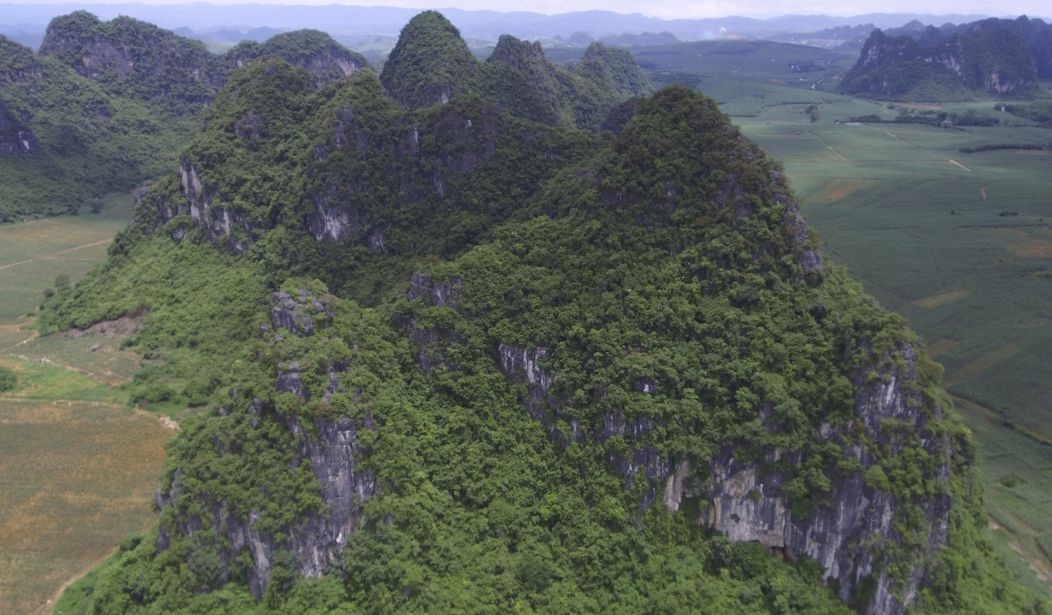Top News
Largest Ape Ever Went Extinct Because of… Climate Change?

Back in the 1930s, paleontologists discovered the fossilized remains of the largest ape known to have ever walked the earth. Standing as much as ten feet tall and weighing more than a quarter of a ton, they named the creature Gigantopithecus and it is only known to have lived in southern China. The ape is believed to have gone extinct between 200,000 and 300,000 years ago. This may seem like a rather odd story to be discussing here, but Gigantopithecus was back in the news this week in the journal Nature for a peculiar reason. A group of scientists has concluded that the monster ape was driven to extinction by climate change. Before all of our friends on the left start leaping to their feet and screaming ‘We told you so,’ we should look at the details of what these scientists are talking about. (Associated Press)
An ancient species of great ape was likely driven to extinction when climate change put their favorite fruits out of reach during dry seasons, scientists reported Wednesday.
The species Gigantopithecus blacki, which once lived in southern China, represents the largest great ape known to scientists — standing 10 feet tall and weighing up to 650 pounds.
But its size may also have been a weakness.
“It’s just a massive animal – just really, really big,” said Renaud Joannes-Boyau, a researcher at Australia’s Southern Cross University and co-author of the study published in the journal Nature.
So the mechanics of this extinction event come down to the Gigantopithecus being a victim of its own evolutionary success, assuming these scientists are correct. It evolved to become so large that it was unable to climb trees or explore alternate food sources during lean times. But they believe that its food supplies were wiped out by climate change. How did that happen?
What was causing climate change way back then? There were only a comparatively tiny number of human beings on the planet in those days and they were primarily poking around with sticks and living a hunter-gatherer lifestyle, not engaging in any sort of industrial activity. Did the giant apes have a fracking program that we haven’t found any evidence of yet?
That’s almost certainly not the explanation. In the end, this may prove to be yet another example of something that many grounded scientists have pointed out and we’ve discussed it here in the past. Analyses of ice core samples and other geologic records tell us that the planet and been going through cycles of heating and cooling for as long as it has existed. There are records of at least five ice ages where the world froze over almost entirely. In the intervening eras, Earth was often noticeably warmer on average than it is today. And all of this kept happening while there were no polluting, oil-drilling humans around to mess up the place.
Speaking of shifting temperatures, have the scientists looked into those types of changes when figuring out how Gigantopithecus went extinct? If you look at the graphic timeline in this report on glacial and interglacial periods of Earth’s history, you notice something that might have been a factor. As noted above, scientists believe that the giant ape may have gone extinct roughly 200,000 years ago. Perhaps it’s just a coincidence, but that period falls right at the end of one of the interglacial warming periods. Right after that, the temperatures plunged and didn’t rise again for the next 50,000 years. Could Gigantopithecus have been the victim of an ice age? That would certainly qualify as an extreme form of “climate change,” but it wasn’t driven by mankind.
In any event, I found the report interesting and thought some of you might as well. And any time the phrase “climate change” is invoked, the left begins setting its hair on fire, so it seemed prudent to head this story off at the pass. Rest in peace, Gigantopithecus. I really would have loved to see one of you in the flesh. Well… from a distance, of course.
Read the full article here

-
Uncategorized6 days ago
The Surge of Crypto Slots: A New Period in Online Pc Gaming
-
Uncategorized6 days ago
Kəşf Etmək Binance Coin Kazino Saytları Dünyasını
-
Uncategorized6 days ago
The Increase of Dogecoin Casino Sites: An Extensive Introduction
-
Uncategorized6 days ago
High Roller Online Casinos: Inside the Globe of Elite Betting
-
Uncategorized2 days ago
The Comprehensive Overview to Tutoring Networks







